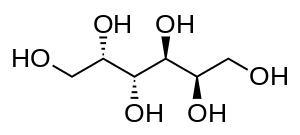Galactitol
 | |
 | |
| Names | |
|---|---|
| IUPAC name
(2R,3S,4R,5S)-hexane-1,2,3,4,5,6-hexol | |
| Other names
D-Galactitol; Dulcitol | |
| Identifiers | |
| 3D model (JSmol) |
|
| ChEBI | |
| ChemSpider | |
| ECHA InfoCard | 100.009.242 |
| PubChem CID |
|
| |
| |
| Properties | |
| C6H14O6 | |
| Molar mass | 182.172 g/mol |
| -112.40·10−6 cm3/mol | |
| Except where otherwise noted, data are given for materials in their standard state (at 25 °C [77 °F], 100 kPa). | |
| | |
| Infobox references | |
Galactitol (dulcitol) is a sugar alcohol, the reduction product of galactose.[1] In people with galactokinase deficiency, a form of galactosemia, excess dulcitol forms in the lens of the eye leading to cataracts.[2]
Galactitol is produced from galactose in a reaction catalyzed by aldose reductase. Galactose itself comes from the metabolism of the disaccharide lactose into glucose and galactose.
The other common galactose metabolism defect is a defect in galactose-1-phosphate uridylyltransferase, an autosomal recessive disorder, which also causes a buildup of galactitol as a result of increased concentrations of galactose-1-phosphate and galactose. The toxicity associated with galactose-1-phosphate uridylyltransferase deficiency is associated with symptoms of hepatosplenomegaly and mental retardation in addition to the cataracts caused by galactitol buildup.
References
- ↑ "Galactitol - Compound Summary". National Center for Biotechnology Information. Retrieved 2008-08-06.
- ↑ Roth, KS (September 10, 2007). "Galactokinase Deficiency". eMedicine. WebMD. Retrieved 2008-08-08.